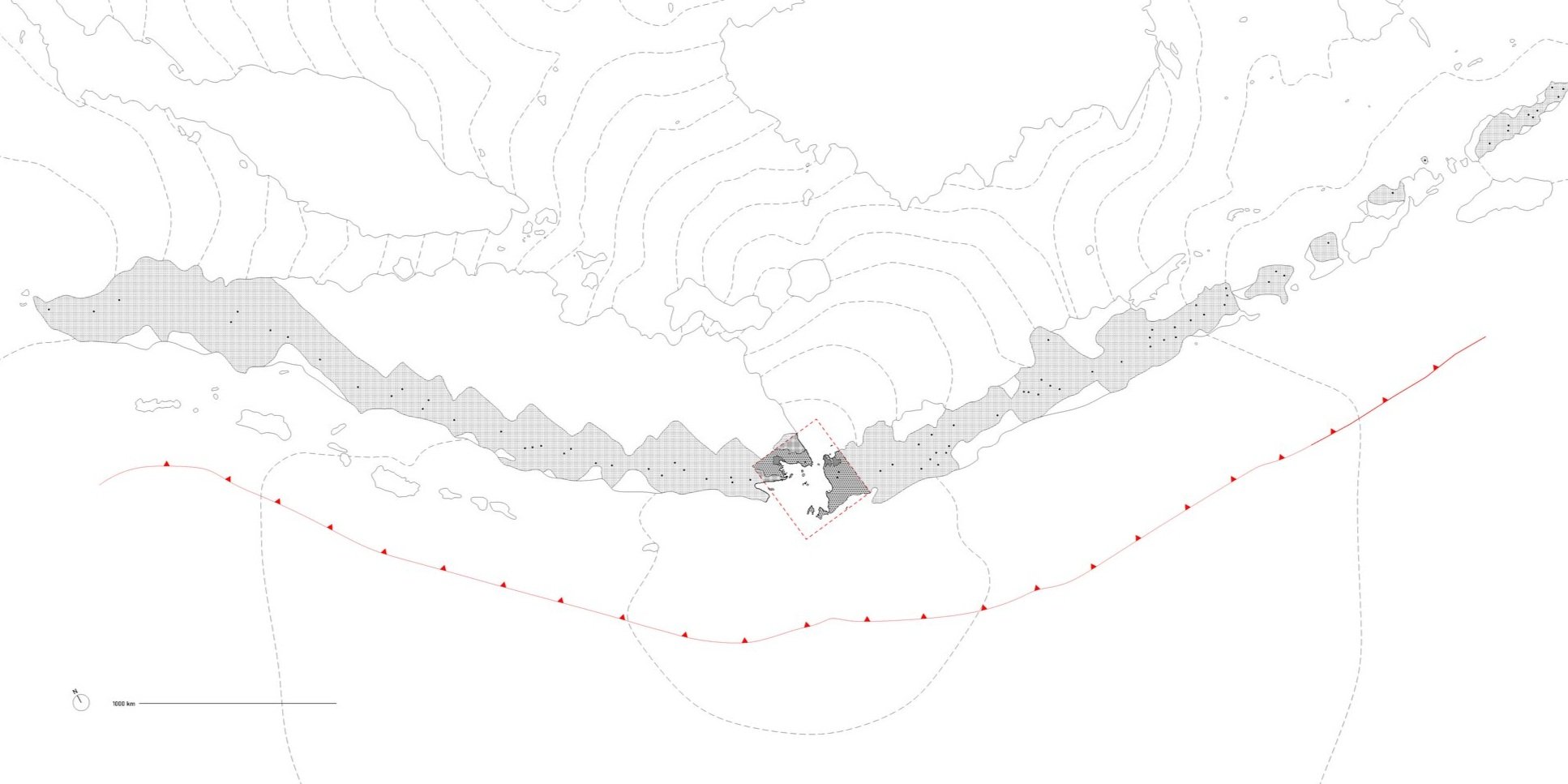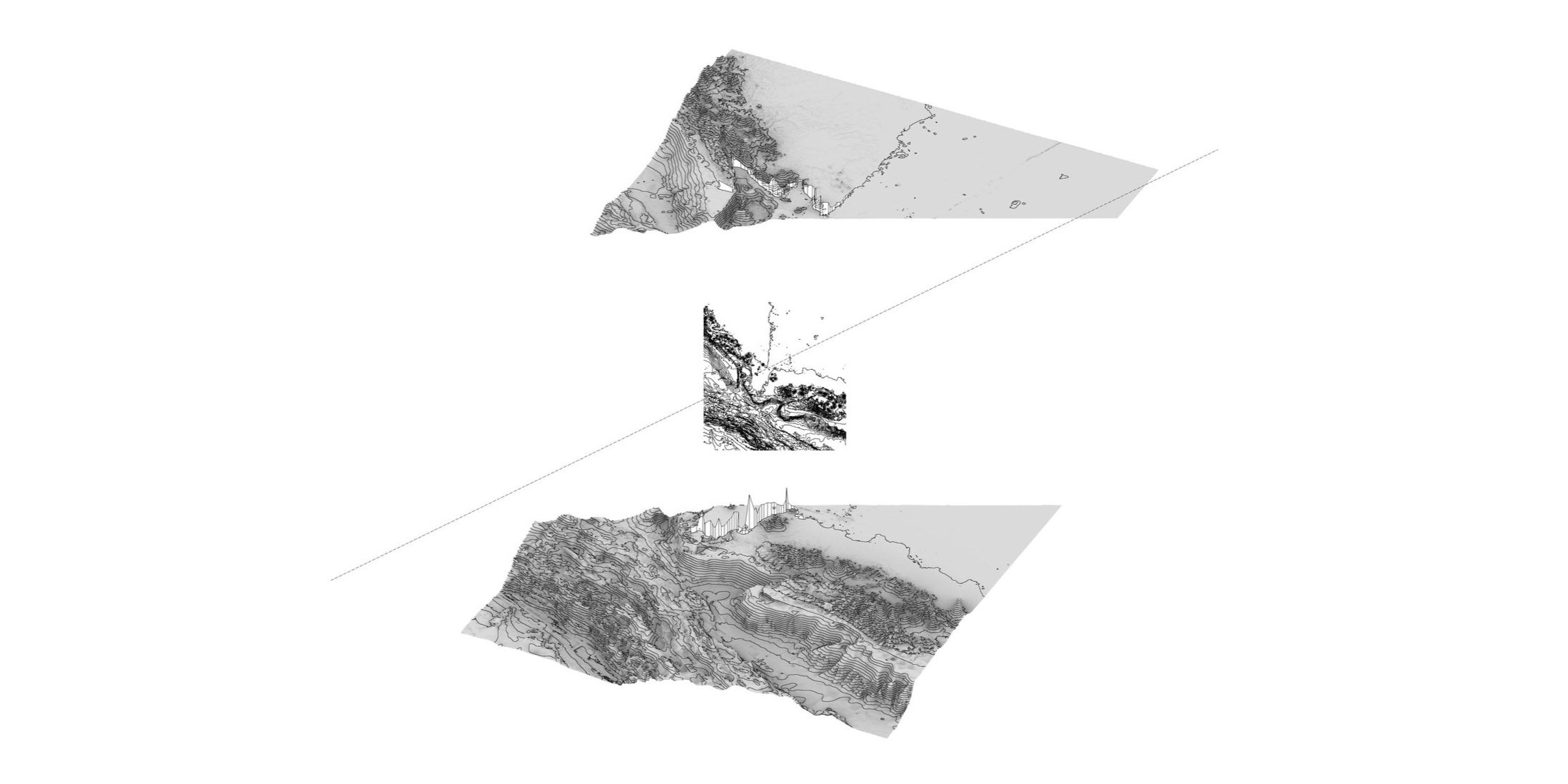
Disaster Map | in collaboration with Peter Ballman’s Disaster Machine Studio | Cornell University, Spring ‘21
Krakatau
DISASTER MACHINES, SPRING '21
Disasters are integral to life on earth. Unknown, unimagined, and unpredictable, disasters accompany all areas of habitation in one form or another. Yet, despite the desire to return to a previous state of equilibrium, one must accept the inevitability of the disaster and its consequences. The stability and predictability of our everyday lives is provided by infrastructure; whether at the periphery of a region, embedded underground or so common it goes unnoticed, infrastructure exists at the edge of human experience. This edge is both physical and innately implies the existence of an integration, incorporating assumptions about ourselves, our needs, and our place in the environment. It is along this edge where disaster occurs. Because we cannot see or experience the physical and technological systems that translate between ourselves and our environment, we are shocked when disasters strike. A disaster is sometimes said to be a failure of imagination, but it can also be a failure of perception and awareness.
Disasters will be used as a catalyst for imagining a new architecture of a more aware and integrated way of life. Nothing should exist in a state of assumed permanence, and the disaster should guide mechanisms for mitigation, perception, and progression to provide a means of both survival and purpose.

Exposure
When we witness a disaster, it can reveal our mortality, and we feel - with varying degrees of harm - closer to what is true about our existence than we allow ourselves to feel in the normal course of living. A theater, populated by different typologies of architecture for different phases of the disaster, will incorporate a new understanding of environmental conditions, a new civic program oriented toward awareness and experience, a new kind of inhabitation and a new normal. While this new inhabitation may not be less vulnerable to disaster, it may be able to suffer the effects less drastically, and to recover more quickly.


The Scream, Edvard Munch, 1893.
Events
Krakatau is an island belonging to a caldera in the Sunda Strait between the islands of Java and Sumatra in the Indonesian province of Lampung. It makes up part of the Indonesian volcanic arc system produced by subduction of the Indo-Australian Plate. The density of the population lives at the edge of the coastline basin surrounding the volcano, where all bear witness to Krakatau and all are susceptible to her destructive reach,
Krakatau releases discharge, with multiple strata of solidified lava, tephra, and volcanic ash. Volcanic activity has been recorded as early as 1680, and to this day Krakatau has continuously released discharge. Her most notable episodes occurred in 1883, of which 36 thousand were killed with tsunami waves 41 meters high, and 2018, of which 437 died, 14 thousand were injured, 40 thousand were displaced with tsunami waves 42 meters high.
In its lifespan Krakatau has assumed numerous forms in its activity, which each form harnessing greater potential for danger in its volume. Seismic eruptions and landslides from the volcano have both resulted in subsequent tsunamis that have devastated the coastline. Soundwaves from eruptions have reached 3000 miles away and were heard in Singapore and Australia. Seismic discharge has penetrated the international jet plume, consequently lowering the world temperature by 1 degrees Celsius for a year. Krakatau has penetrated the consciousness of everyday activity through its satellite impacts, embedding its cultural significance and underlying human social, civic and urban organization.
Causes
There are two main causes for the most devastating part of the disaster, or the tsunami: seismic activity, caused by subduction of the underlying plates, resulting in seawater penetrating magma chambers causing high pressure build up, and volcanic landslide, of which activates a tsunami due to oceanic mass displacement. The subsequent tsunami reaches the coastline within 30 minutes of the event, with wave heights at the coastline exceeding 16 meters. These various runup heights have devastated the coastline, and have caused different degrees of damage on different housing typologies of construction. To understand the mitigation of the eruption, the timeline of volcanic events, and the various human values involved, their arrangement is catalogued by vicinity relative to Krakatau and their features fall under three values of human condition: confusion, confinement, and witness.
An infrastructure is implemented to witness the various phases of the disaster. First what is routine and ordinary, followed by preemptive deficiencies that serve as warnings, then confrontation with the discharge of the volcano, and the resulting aftermath. The infrastructure will be activated by the disaster.
Frieze of Life
SERIES BY EDVARD MUNCH
The Frieze of Life series by Edvard Munch provides insight into the human conditions of those affected by Krakatoa. Through four stages, this series illustrates the chronology of human life and experience through love and death:
Seeds of Love - human fates are united before their disappearance
The Flowering and Passing of Love - separation of fate and loss of desire
Anxiety - of which humans re confronted by their demons
Death - where we exist at the fringe until we become engulfed by illness and death


Site
The selected site is located closest to Krakatau, where some of the most severe destruction of the tsunami has been recorded. It is at the coastline of a twin unactive volcanic mass that is active in freshwater rain runoff. The locals live at the very edge of the coastline, and despite repeated destruction by Krakatau, the inhabitants remain exposed and vulnerable. Since the population neglects to relocate to less hazardous areas, and does not rebuild with more resilient methods and materials, the coastline will turn to ruin time and time again. Instead of fixing the existing housing practice, an infrastructure is implemented to enhance the public sphere. Under the terms established by the volcano, the infrastructure will render the coastline more resilient, providing points and connective tissue that face Krakatau, and are activated or come to fruition with the oncoming tsunami. Various conditions for static rest and circulatory movement are provided as well as different means of meandering, efficient or immediate evacuation into the hillside. Upon the retreat of the tsunami back into the ocean, the system should hold debris and human bodies such that they can be recovered, as well as sea water to combat ash and lava bomb dispersion.
Prototypes of Resistance
Upon your evacuation, as you are fleeing to safety, you may not make it, and if you are going to die, you would want others to know what happened to you. Thus, direct passage is centralized such that your evacuation can be viewed by those in refuge, with vision of the oncoming disaster and without. The prototypes of resistance consist of:
Moving Theater - evacuation is provided from all directions where there is no land rise, so that refuge can be taken, lifted, and carried with corresponding tsunami wave height | additional saltwater collection for ash mitigation
Inhabit the Wall - serves for immediate evacuation to higher ground behind a wall to protect from water surge | passively holds static, renewal, flow-through, and re-circulatory conditions of water | two separate axes for human and freshwater circulation
Shield Wall - collapsible wall | activated by the tsunami to only provide immediate shelter upon contact with a large body of water | serves to elevate those seeking immediate refuge above the surging water | shields from falling lava bombs and ash | device offers multiple uses as the user deems fit, you can attempt refuge by nesting in its core, or accept possible demise on its upper stage if death is deemed unavoidable
Collapsible Wall - elevated walk serving for immediate evacuation to higher ground of which water can flow through and out the device to minimize the force of water | each space behind the wall contains refuge behind circulation, or bears witness to Krakatau







































